M
I
C
R
O
S
T
O
R
Y
O
F
A
R
T
........................................................

NOW COMPLETED:

........................................................
MICROSTORY OF ART
ONLINE JOURNAL FOR ART, CONNOISSEURSHIP
AND CULTURAL JOURNALISM
........................................................
INDEX | PINBOARD | MICROSTORIES |
FEATURES | SPECIAL EDITIONS |
HISTORY AND THEORY OF ATTRIBUTION |
ETHNOGRAPHY OF CONNOISSEURSHIP |
SEARCH

........................................................



 >MICROSTORIES
>MICROSTORIES
- Richard Serra
- Martin Scorsese
- Claude Simon
- Sunshine
- Werner Herzog
- The Creation
- Marcel Duchamp
- Nino Rota
- Wölfflin and Woolf
- Hansjörg Schneider
- Kraftort Arkadien
- Visual Biography
- Schlaraffenleben
- Die Geisteswissenschaften
- The Voyeur
- Buzzword Sustainability
- Paul Verlaine
- Tao Yuanming
- New Beginning
- Seneca
- Still Lifes
- Charles Baudelaire
- Frédéric Chopin
- The Art History of Sustainability
- Wang Wei
- Solarpunk
- Historians of Light
- Lepanto
- Renaturalization
- Plates
- Snow in Provence
- Learning to See
- Picasso Dictionaries
- Peach Blossom Spring
- Picasso Tourism
- Tipping Points
- Sviatoslav Richter
- Weather Reports
- Treasure Hunt
- Another Snowscape in Picasso
- Picasso in 2023
- Dragon Veins
- The Gloomy Day
- The Art of the Pentimento
- Reforestation
- The Status of Painting
- Emergency Supply
- Punctuality
- Watching Traffic
- Zhong Kui
- How Painting Survived the 1990s
- Confirmation Bias
- Sustainability and Luxury
- Garage Bands
- Picasso and Artificial Intelligence
- Eyes of Tomorrow
- Picasso in 2023 2
- Gluing Oneself to Something
- Suburbia
- Bamboo
- Sustainability and Carpe Diem 1
- Interviews with Bruegel
- Sustainability and Carpe Diem 2
- Coffee & Sugar
- Bamboo 2
- Picasso in 2023 3
- Sustainability and Carpe Diem 3
- Cherry Orchard
- Old Magazines
- Chance
- Nick Drake
- Harlequin
- The Smartphone & the Art Book
- Atlas Syndrome
- The Kitchen
- Atlas Syndrome 2
- Consideration
- Tori Amos
- School
- Orchard Auctioning Day
- The Hundred Years’ War
- Sócrates
- Chameleon
- Nefertiti Bust
- Picasso as a Computer
- Sunflowers
- Philemon & Baucis
- Ode to the Radio
- Childhood
- Wimmelbild
- Restitution
- Nick Drake 2
- Wishful Thinking
- Sundays
- The Independent Scholar
- September
- The Fisherman by Pirosmani
- Microadventure
- Sociology
- Salvator Mundi
- Chillon
- Appassionata
- Amber
- Homer
- Berlin
- Planet Walk
- Improvisation
- Seeing Picasso
- These Nice Kids
- Robber
- The One
- The Sea Turtle
- Zoo
- Through the Hush
- Wunderkammer
- I Do Not Seek, I Find
- Shopping Mall
- Food Hamper
- The Secretary
- This Gate
- Nor Rainy Day
- House on a Hill
- Beautiful Island
- Second-hand Bookstore
- Flat
- Slap in the Face
- Serra, Wenkenpark
- Apologies
- The Bells
- Nordmann Fir
- Picasso Wanting To Be Poor
- Picasso, Pirosmani
- A Brief History of Sculpture
- 24 Sunsets
- Rusty Phoenix
- Glove
- Wintry Stanza
- A Song
- Like A Beatle
- Catching An Orange
- Solar Bees
- Permaculture

 >FEATURES
>FEATURES
- Van Gogh On Connoisseurship
- Two Museum’s Men
- Ende Pintrix and the City in Flames
- Titian, Leonardo and the Blue Hour
- The Man with the Golden Helmet: a documentation
- Un Jury d’admission à l’expertise
- Learning to See in Hitler’s Munich
- Leonardo da Vinci and Switzerland
- The Blue Hour Continued
- The Blue Hour in Louis Malle
- Kafka in the Blue Hour
- Blue Matisse
- Blue Hours of Hamburg and LA
- A Brief History of the Cranberry
- The Other Liberale in the House
- The Blue Hour in Raphael
- Who Did Invent the Blue Hour?
- Monet on Sustainability
- Velázquez and Sustainability
- The Blue Hour in Guillaume Apollinaire
- Van Gogh on Sustainability
- The Blue Hour in Marcel Proust
- Picasso and Sustainability
- The Contemporary Blue Hour
- The Blue Hour in 1492
- The Blue Hour in Hopper and Rothko
- Hopper and Sustainability
- The Blue Hour in Ecotopia
- The Hour Blue in Joan Mitchell
- Explaining the Twilight
- The Twilight of Thaw
- The Blue Hour in Pierre Bonnard
- Explaining the Twilight 2
- Picasso on Stalin
- Rubens on Sustainability
- The Salvator Mundi in Bruegel and Rubens
- The Blue Hour in Leonardo da Vinci and Poussin
- The Blue Hour in Rimbaud
- Faking the Dawn
- Frost and Thaw in Ilya Ehrenburg
- Picasso, Stalin, Beria
- Picasso, Solzhenitsyn and the Gulag
- Shostakovich on Picasso
- Hélène Parmelin in 1956
- Historians of Picasso Blue
- Picasso Travelling to Moscow 1
- The Blue Hour in Caravaggio
- Picasso Travelling to Moscow 2
- Picasso, the Knife Game and the Unsettling in Art
- Some Notes on Leonardo da Vinci and Slavery
- Picasso Moving to the Swiss Goldcoast
- The Blue Hour in Camus
- The Blue Hour in Symbolism and Surrealism
- Caspar David Friedrich in His Element
- Exhibiting the Northern Light
- Caspar David Friedrich in His Element 2
- Robert Schumann and the History of the Nocturne
- The Blue Hour in Robert Schumann
- Caspar David Friedrich and Sustainability
- The Twilight of Thaw 2
- Multicultural Twilight
- The Blue Hour in Anton Chekhov
- The Blue Hour in Medieval Art
- Twilight Photography
- The Blue Hour in Bob Dylan
- Iconography of Optimism

 >SPECIAL EDITIONS
>SPECIAL EDITIONS
- Visions of Cosmopolis
- Mona Lisa Landscapes
- Turner and Ruskin at Rheinfelden
- Painters On TV & On TV
- Spazzacamini in Art
- A Last Glance at Le Jardin de Daubigny
- The Experimental Cicerone
- A Dictionary of Imaginary Art Historical Works
- Iconography of Blogging
- Begegnung auf dem Münsterplatz
- Cecom
- Das Projekt Visual Apprenticeship
- Those Who See More
- A Fox on Seeing with the Heart
- Sammlung Werner Weisbach
- Daubigny Revisited
- Some Salvator Mundi Microstories
- Some Salvator Mundi Afterthougths
- Some Salvator Mundi Variations
- Some Salvator Mundi Revisions
- A Salvator Mundi Questionnaire
- A Salvator Mundi Puzzle
- Unknown Melzi
- Francis I and the Crown of Charlemagne
- From Amboise to Fontainebleau
- Drones Above Chambord
- Looking Back At Conques
- Flaubert At Fontainebleau
- Images of Imperial Ideology
- The Chronicles of Santa Maria delle Grazie
- Seeing Right Through Someone
- Melzi the Secretary
- Eying Glass
- A Foil to the Mona Lisa
- A Renaissance of the Cartoon
- Sketching a Family Tree
- Venetian Variations
- A Brief History of Digital Restoring
- A Consortium of Painters
- Leonardeschi and Landscape
- A Christ in Profile
- Learning to See in Spanish Milan
- A History of Gestures
- Leonardo and Josquin
- A Renaissance of the Hybrid
- Suida and Heydenreich
- The Watershed
- Three Veils
- From Beginning to End
- Connoisseurship of AI
- Twilight and Enlightenment
- The Blue Hour in Chinese Painting
- Dusk and Dawn at La Californie
- Iconography of Sustainability
- The Blue Hour in Goethe and Stendhal
- The Sky in Verlaine
- The Blue Hour in Paul Klee
- Iconography of Sustainability 2
- The Blue Hour in Charles Baudelaire
- From Bruegel to Solarpunk
- Some Salvator Mundi Documentaries
- Some More Salvator Mundi Monkey Business
- The Windsor Sleeve
- Brigitte Bardot’s Encounter with Picasso
- Art Historians and Historians
- A Salvator Mundi Chronicle
- The Salvator Mundi and the French Revolution
- The Fontainebleau Group
- The Encounter of Harry Truman with Pablo Picasso
- The Fontainebleau Group Continued
- The Windsor Sleeve Continued
- The Salvator Mundi in Early Netherlandish Painting 1
- Some Salvator Mundi Resources
- A New Salvator Mundi Questionnaire
- The Woman in Picasso
- The Yarborough Group
- Melzi, Figino and the Mona Lisa
- The Yarborough Group Continued
- A Salvator Mundi Global History
- The Salvator Mundi in Medieval Art
- The Salvator Mundi in Medieval Art 2
- The Salvator Mundi in Early Netherlandish Painting 2


 >HISTORY AND THEORY OF ATTRIBUTION
>HISTORY AND THEORY OF ATTRIBUTION
- The Mysterious »Donna Laura Minghetti-Leonardo«
- Assorted Demons of Connoisseurship
- Panofsky Meets Morelli
- Discovering the Eye of Sherlock Holmes
- Handling the Left-handed Hatchings Argument
- Visual History of Connoisseurship
- Alexander Perrig
- Connoisseurship in 2666
- What Postmodernity Has Done to Connoisseurship
- Dividing Four Fab Hands
- A Leonardesque Ambassador
- Test Cases in Connoisseurship
- A Raphael Expertise
- How to Tell Titian from Giorgione
- Louise Richter
- The Unique Property in the History of Connoisseurship
- An Expertise by Berenson
- The Book of Expertises
- An Album of Expertises
- An Expertise by Friedländer
- A Salvator Mundi Provenance
- How to Tell Leonardo from Luini
- An Expertise by Crowe and Cavalcaselle
- An Expertise by Bayersdorfer
- An Expertise by Hermann Voss
- An Expertise by Hofstede de Groot
- Leonardeschi Gold Rush
- An Unknown »Vermeer«
- An Expertise by Roberto Longhi
- An Expertise by Federico Zeri
- A Salvator Mundi Geography
- A Salvator Mundi Atlas
- The Bias of Superficiality
- 32 Ways of Looking at a Puzzle
- James Cahill versus Zhang Daqian
- Five Fallacies in Attribution
- On Why Art History Cannot Be Outsourced to Art Dealers
- On Why Artificial Intelligence Has No Place in Connoisseurship
- Salvator Mundi Scholarship in 2016
- Leonardo da Vinci at the Courts
- The Story of the Lost Axe
- The Last Bruegel
- A Titian Questionnaire
- On Where and Why the Salvator Mundi Authentication Did Fail
- The Problem of Deattribution

 >ETHNOGRAPHY OF CONNOISSEURSHIP
>ETHNOGRAPHY OF CONNOISSEURSHIP
MICROSTORY OF ART
ONLINE JOURNAL FOR ART, CONNOISSEURSHIP
AND CULTURAL JOURNALISM
........................................................

***
ARCHIVE AND FURTHER PROJECTS

1) PRINT


***
2) E-PRODUCTIONS


........................................................

........................................................

........................................................
FORTHCOMING:


***
3) VARIA

........................................................

........................................................

........................................................

........................................................

........................................................
***
THE GIOVANNI MORELLI MONOGRAPH

- The Giovanni Morelli Monograph
........................................................
MICROSTORY OF ART
ONLINE JOURNAL FOR ART, CONNOISSEURSHIP AND CULTURAL JOURNALISM
HOME
MICROSTORY OF ART ONLINE JOURNAL FOR ART, CONNOISSEURSHIP AND CULTURAL JOURNALISM Melzi the Secretary 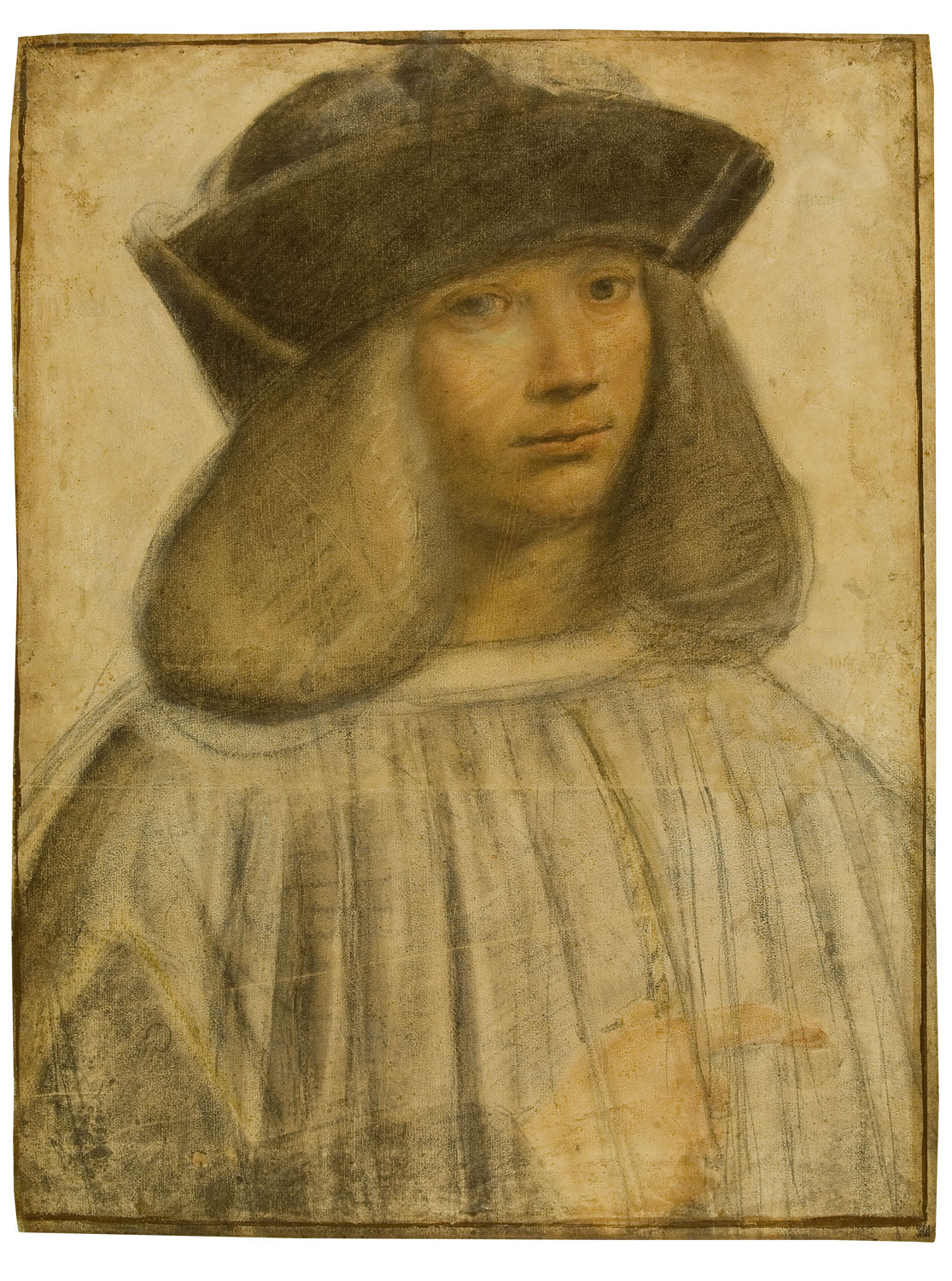 |
See also the episodes 1 to 10 of our New Salvator Mundi History:
Francis I and the Crown of Charlemagne
The Chronicles of Santa Maria delle Grazie
And:
Melzi the Secretary
(28.7.2021) Leonardo scholarship is in the habit of copying Leonardo: by leaving many projects unfinished. But Leonardo
scholarship is not in the habit of copying Leonardo in one respect: in defining problems and attempting to solve them.
Because every reader who only dabbles in Leonardo’s writings must find: this is a man who obviously was attracted to
(theoretical as well as practical) problems and, yes, also a man who obviously had fun, someone who was feeling at ease
trying to solve them.
In the 1990s a German scholar once made a list of problems, of things we do not know or do not know very well as regards
Leonardo, but nothing has come of this. And on that list, if I am recalling this correctly, there was nothing as to the
people in Leonardo’s orbit anyway, as if Leonardo had only existed within his own sphere. Francesco Melzi, as I already
have said and shown, causes a problem that Leonardo scholarship never seriously has addressed. And a Francesco Melzi
scholarship does not exist either. Why not starting one? But we have to start with defining problems and identifying the
stereotypes and contradictions within Leonardo literature and especially Leonardo biographies. Because there is one
tendency, one basic law (and I like to call it the Melzi law), of speaking of Melzi only as Leonardo’s secretary. He
might have been this, but the more and the more decisively one does speak of Melzi the secretary and only as the
secretary (and not as painter in his own right), the more you will be surprised that contemporary sources also saw Melzi
as a painter, that people have attributed pictures (and very fine ones) to Melzi, and that Leonardo inherited everything
that had to do with his profession as a painter to Melzi. Here comes the eleventh episode of our New Salvator Mundi
History, and it is just about one portrait left unfinished: the portrait of Melzi the secretary – the portrait of
Melzi the painter (picture of Villa Melzi at Vaprio d’Adda above: MarkusMark; title: Thomas de Keyser.

One) Stereotypes and Contradictions
Melzi was a nobleman, yes. And one recent Leonardo biographer has laboured to make this the explanation for Melzi not
having being a professional painter. Because the mechanical arts were not seen as appropriate a way of making a living
for a nobleman. But the same Leonardo biographer also does discover that for Boltraffio this obviously did not cause a
problem, apart from the fact that Leonardo had strived exactly for this: to make painting something more than a
discipline of the mechanical arts, a science, an art in its own right. And apart from the fact that, as also the same
biographer does concede, Melzi-attributed pictures resemble very much in style those of Leonardo, so that we have to
assume that the secretary, by some way of osmosis, must have learned to paint in the manner of Leonardo. But all this
does not make much sense.
Another recent Leonardo biographer tells us that Melzi was never a ›master painter‹ (whatever that means), only to
(uncritically) confirm that Melzi did paint one of the best versions of the Leda, while not telling us that Melzi, in
later years, seems to have taught or cooperated with the painter Gerolamo Figino. This does not make much sense either.
If, frustrated by more recent Leonardo biographies (the best being that of Charles Nicholl, may at least he be named), we
turn to the classic short biography by Kenneth Clark, we learn that Melzi was Leonardo’s ›friend and disciple‹. And
›disciple‹ or ›pupil‹ are indeed the words we should use, if we concede that Melzi must have been someting more than a
mere ›secretary‹.
But what sources do we have to work with?
I am proposing that we start with looking at what the ambassador of the duke of Ferrara wrote to his master in 1523:
Melzi is described as someone who paints very well – ›as far as I can judge‹, the ambassador says, which rules out
the possibility that the ambassador here only does report hearsay. He does not fully trust his own judgment, or wants to
appear as being modest, but the ambassador obviously has seen things Melzi had painted, or things the ambassador thought
Melzi must have painted. And Melzi is being described, in this source, as likable and very intelligent, not to forget.
I am proposing that we take this source (quoted, after Beltrami, for example in Volker Reinhardt’s Leonardo biography,
p. 332) as our starting point and then work our way backwards.
What does backwards mean? This means that we now take a look at Leonardo’s will of 1519 and at the description of the
journey across Europe that the cardinal Luigi d’Aragon did make in 1517/18, a description by the cardinal’s secretary
Antonio de’ Beatis. Only to arrive then, and only then, at the problem of the Prado Mona Lisa (below we see the
Leda version of the Uffizi).
Two) Working Our Way Backwards
I am not interested in the details of Leonardo’s will here (text for example in Shaw 2014), but we should take a look at
least at one paragraph (translation as Shaw has it):
»The aforesaid Testator gives and bequeaths to Messer Francesco da Melzi, nobleman of Milan, as a reward for the gracious
services he has rendered in the past, all and each of the books the said Testator possesses at the present time, and the
other instruments and portraits appertaining to his art and calling as a painter.«
Superficial scholars may think only of Leonardo’s manuscripts here as well of his drawings, but ›appertaining to his art
and calling as a painter‹ must mean here: also the cartoons as well as the preparatory drawings, brief all the
instruments that would have made it possible to continue working not ony in the style of Leonardo, but with his own
tools, and thus in his footsteps, including the methods of serial production (as far this was possible on the basis of
cartoons and preparatory drawings).
Now while Melzi is named in Leonardo’s will, he is not named in Antonio de’ Beatis famous account. But is Melzi implied, if
the secretary of the cardinal of Aragon does say that there, at Amboise in 1517, was one pupil (working well), who
continued, supervised by Leonardo teaching (and also still drawing) obviously painterly work? Isn’t it rather obvious
that this pupil must have been Melzi, to whom, two years later, Leonardo was to bequeath everything ›appertaining to
painting‹?
Yes, theoretically, it could be Salaì. If Melzi does not fit into your scheme, you will now turn to Salaì, to whom
Leonardo did not bequeath everything appertaining to his art and calling as a painter. Who is not named either,
who was only paid by the king of France as Leonardo’s servant (and not even all the time), and who seems to have produced
a signed and dated picture of Christ in 1511 that does raise questions as to his, Salaì’s accomplishments as a painter.
And in addition to that: there are no contemporary sources to convince us that Salaì did paint well. We have named here two
sources naming (respectively: implying probably) Melzi. And there are also other, later sources, that I am not going into
here. And certainly, Salaì died early, but we don’t hear anything either as to Salaì having taught or worked with other
painters. What we hear is Vasari saying that pictures by Salaì that had been retouched by Leonardo passed as originals in
Milan. Whatever we make of that. Those who are familiar with the history of Leonardo attributions must know that (another
law) everything is attributed to Leonardo everywhere at any point in time.
Three) The Prado Mona Lisa, Again
The reactions of leading Leonardo scholars as to the Prado Mona Lisa and as to the Prado attributing the picture to
›Melzi or Salaì‹ have been disappointing. Martin Kemp, who also seems not to be fully convinced that Antonio de’ Beatis,
in his account from Amboise, is referring to Melzi (see Kemp’s book on the Mona Lisa; a question mark is put behind
the name of Melzi), does simply state that the attribution is »unconvincing« (p. 213), and that we don’t have a reliable
corpus of Melzi pictures. Which is true, we have only some sort of corpus, and what we don’t have is a consensus in any
way, and we don’t have a Melzi scholarship, due to Leonardo scholars having neglected Melzi for a very long time. And due
to Leonardo scholars still neglecting Melzi. Despite of the Prado having proposed that the Prado Mona Lisa could be by Melzi.
Why is it reasonable to think of Melzi?
Because it is reasonable to assume, as Kemp does, that Leonardo continued working on the Mona Lisa (which probably
had not been commissioned by Giuliano de’ Medici), due to Giuliano de’ Medici wishing the picture to be finished. And
this would mean, around the year of 1512. At this time, Melzi, who still was very young, had already passed several years
in the orbit of Leonardo. It would have made sense that a copy of the Mona Lisa, which shows, due to technical
examinations, that it had been done ›in parallel‹ to the original, was started at exactly this period. When the
copyist could copy what Leonardo already had painted (in 1503ff.), to go on working with him and close to him ›in parallel‹.
Again: theoretically it could be Salaì. We don’t know much as to the trajectories of Melzi and Salaì during the years to
follow. Did Salaì advance, or did a more talented Melzi outshadow him, so that he turned to selling his pictures
(retouched by Leonardo) as Leonardo originals? But seriously: We have pictures and we have to place them somewhere. If
for example Pietro C. Marani is right that a study for the Berlin Pomona and Vertumnus (below) has been done by Melzi
c. in 1515-1520, then Melzi did this rather after he did the Mona Lisa copy, and while he was with Leonardo (and Salaì)
in France.
We have dates, we have pictures to work with, we have sources, we have defined problems, and we have questions (for
example what exactly did Melzi paint at Amboise?). Why we don’t have also a Francesco Melzi scholarship? Because we still
have to start one. Melzi is the assumed author of the above shown portrait of Leonardo. Now we have to work towards his
portrait – as a painter, and yes, also as a secretary.
Selected literature:
Ludwig Pastor, Die Reise des Kardinals Luigi d’Aragona durch Deutschland, die Niederlande, Frankreich
und Oberitalien, 1517-1518, beschrieben von Antonio de Beatis, Freiburg i.B. 1905
Richard Shaw Pooler, Leonardo Da Vinci’s Treatise of Painting, The Story of the World’s Greatest Treatise
on Painting Its Origins, History, Content and Influence, Wilmington 2014
1495: At around this date Leonardo da Vinci is supposed to have begun The Last Supper. Giampietrino is documented as an active painter.
1516: Paolo Emilio, Italian-born humanist at the court of Francis I, publishes the first four books of his history of the Franks; death of Boltraffio.
1517: Leonardo da Vinci, with Boltraffio and Salaì, has come to France (picture of Clos Lucé: Manfred Heyde); 10.10.2017: Antonio de Beatis at Clos Lucé
1517ff: Age of the Reformation; apocalyptic moods; Marguerite of Navarre, sister of Francis I, will be sympathizing with the reform movement; her daughter Jeanne d’Albret, mother of future king Henry IV, is going to become a Calvinist leader.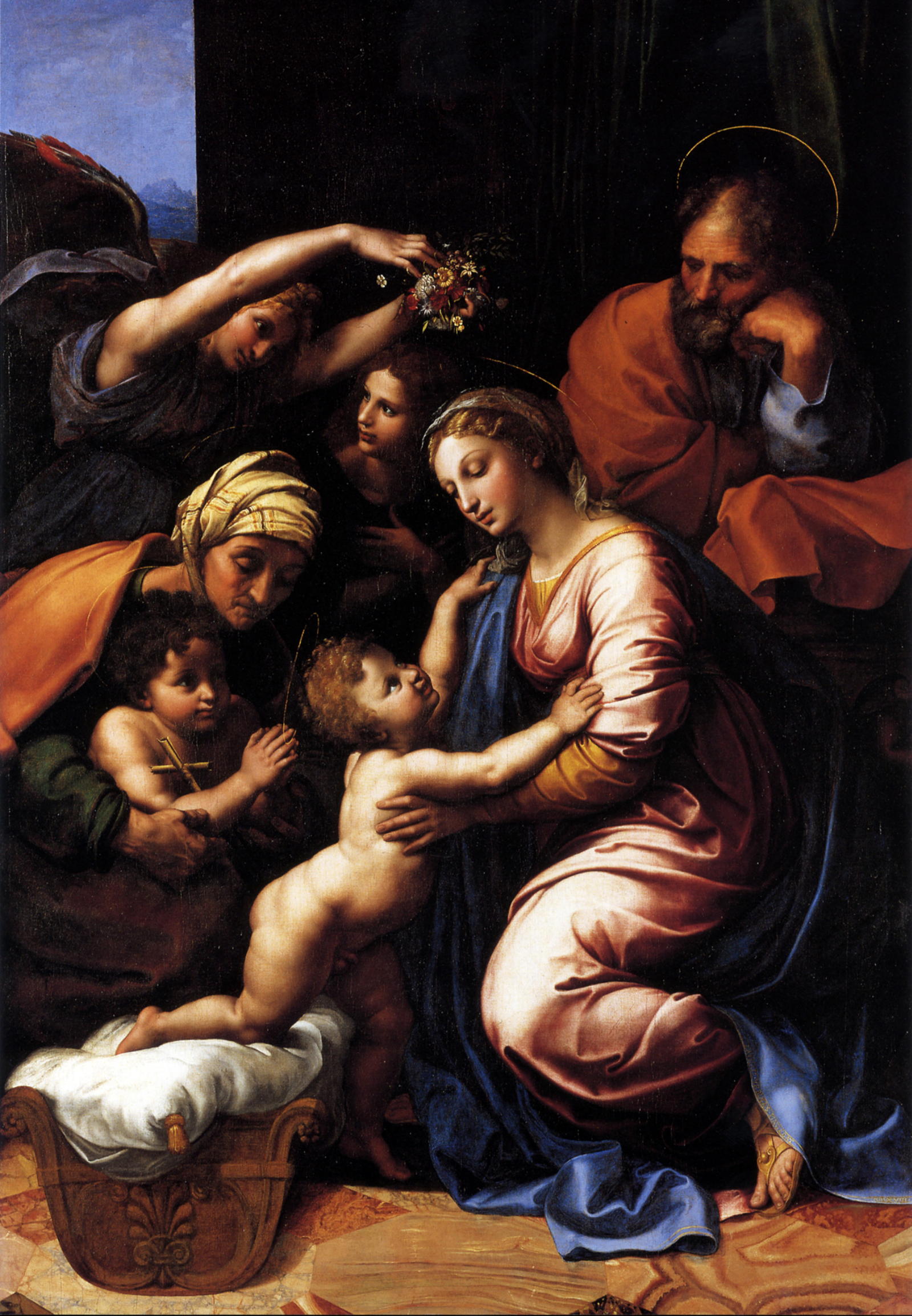
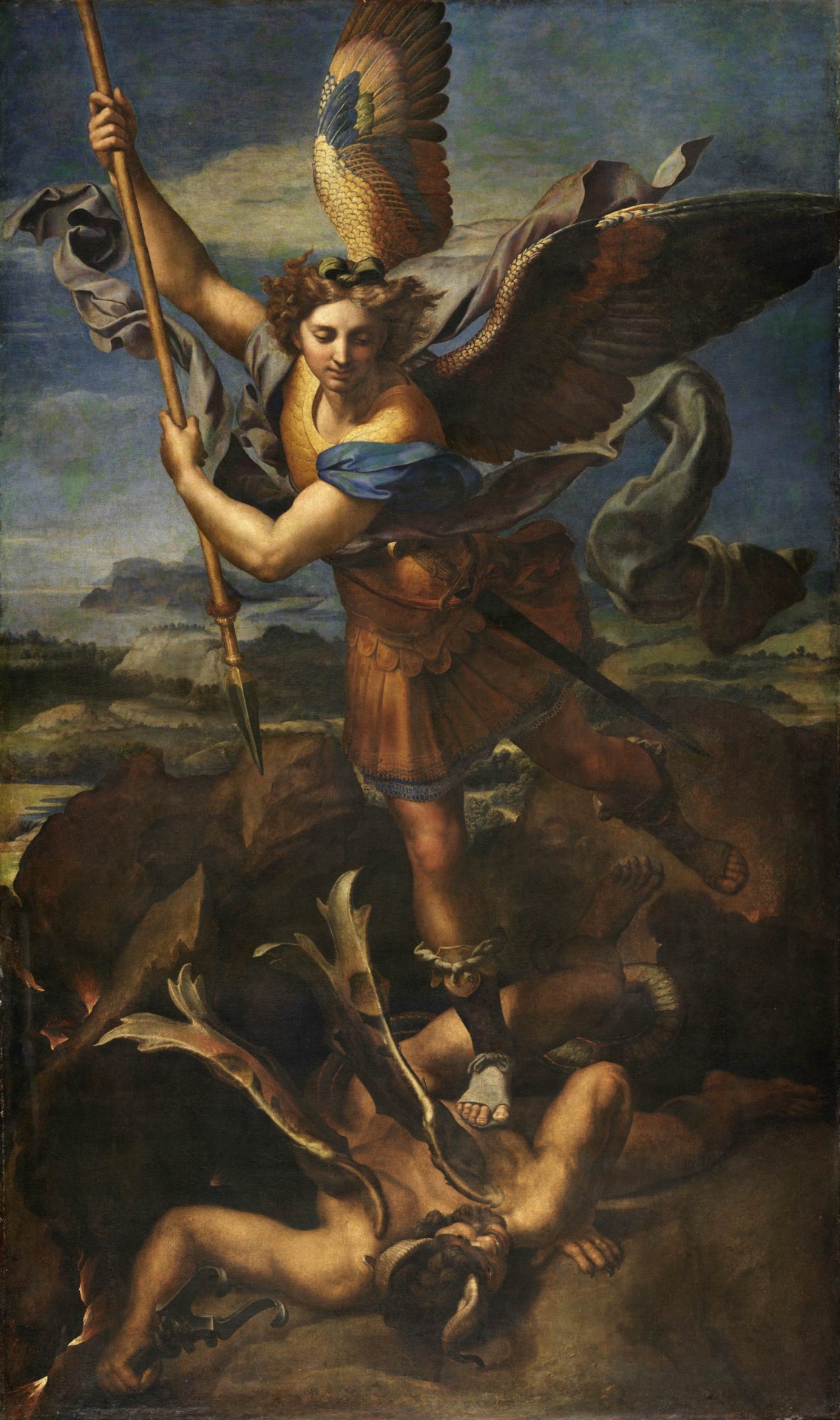
1518: the Raphael workshop produces/chooses paintings to be sent to France; 28.2.: the Dauphin is born; 13.6.: a Milanese document refers to Salaì and the French king Francis I, having been in touch as to a transaction involving very expensive paintings: one does assume that prior to this date Francis I had acquired originals by Leonardo da Vinci; 19.6.: to thank his royal hosts Leonardo organizes a festivity at Clos Lucé.
1519: death of emperor Maximilian I; Paolo Emilio publishes two further books of his history of the Franks; death of Leonardo da Vinci; Francis I is striving for the imperial crown, but in vain; Louise of Savoy comments upon the election of Charles, duke of Burgundy, who thus is becoming emperor Charles V (painting by Rubens).
1521: Francis I, who will be at war with Hapsburg 1526-29, 1536-38 and 1542-44, is virtually bancrupt.
1523: death of Cesare da Sesto.
1524: 19.1.: death of Salaì after a brawl with French soldiers at Milan.
1525: 23./24.2.: desaster of Francis I at Pavia. 21.4.1525: date of a post-mortem inventory of Salaì’s belongings.
1528: Marguerite of Navarre gives birth to Jeanne d’Albret (1528-1572) who, in 1553, will give birth to Henry, future French king Henry IV.
1530: Francis I marries a sister of emperor Charles V.
1531: death of Louise of Savoy; the plague at Fontainebleau.
1534: Affair of the Placards.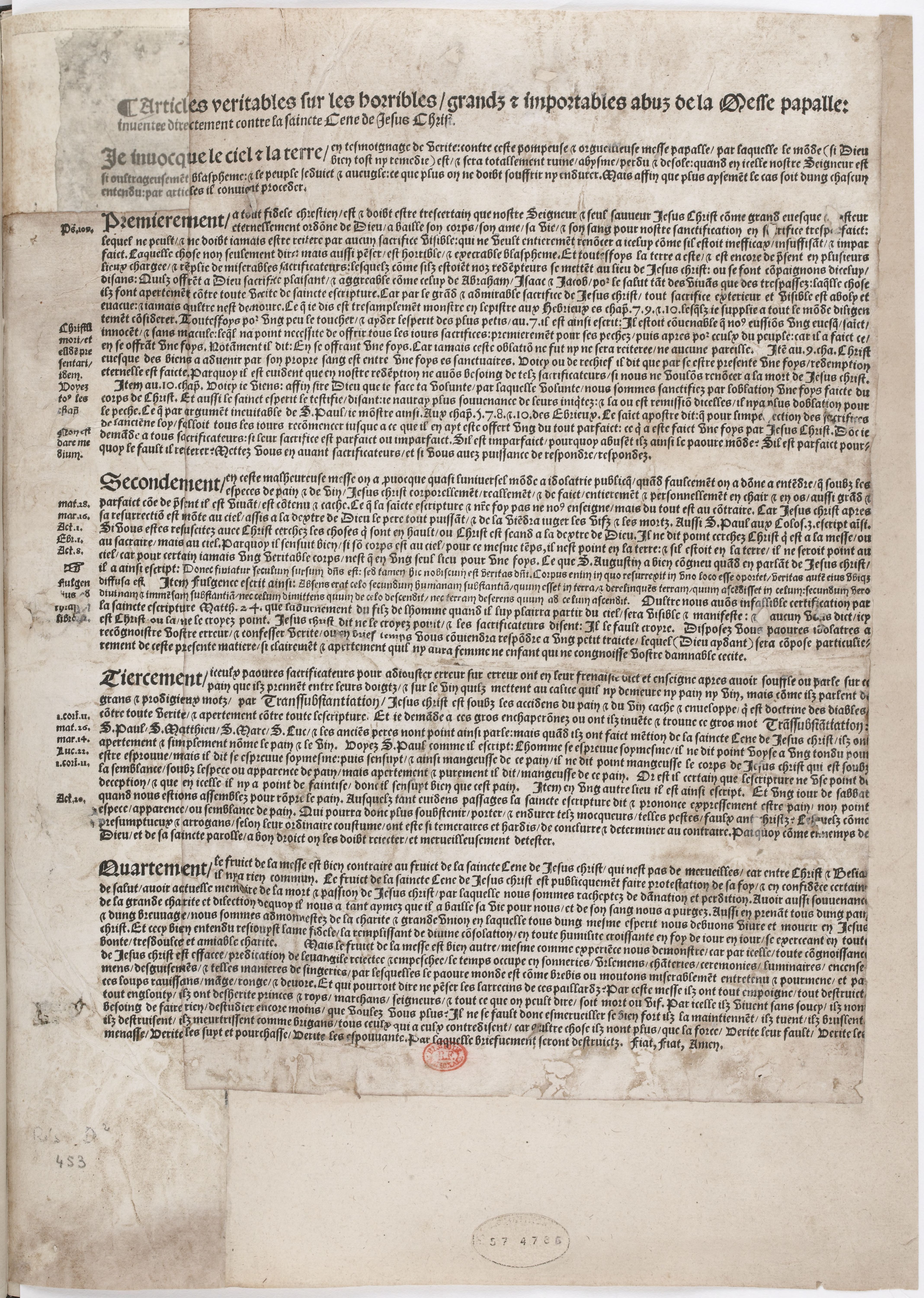
1539: the still unfinished chateau of Chambord is being shown by Francis I to Charles V.
1540s: the picture collection of Francis I being arranged at Fontainebleau.
1544: January: Marguerite of Navarre sends a letter of appreciation to her brother, king Francis I., who has sent her a crucifix, accompanied by a ballade, as a new year’s gift.
1547: death of Francis I.
1549: death of Marguerite de Navarre; death of Giampietrino.
1553: Jeanne d’Albret gives birth to Henry, the future French king Henry IV and first Bourbon king after the rule of the House of Valois.
1559: publication of the Heptaméron by Marguerite de Navarre.
1562-1598: French Wars of Religion.
1570: death of Francesco Melzi.
1589: Henry, grandson of Marguerite de Navarre and grand-grandson of Louise of Savoy, but by paternal descent a Bourbon, is becoming French king as Henry IV.
2015: an exhibition at the Château of Loches is dedicated to the 1539 meeting of king and emperor (see here).
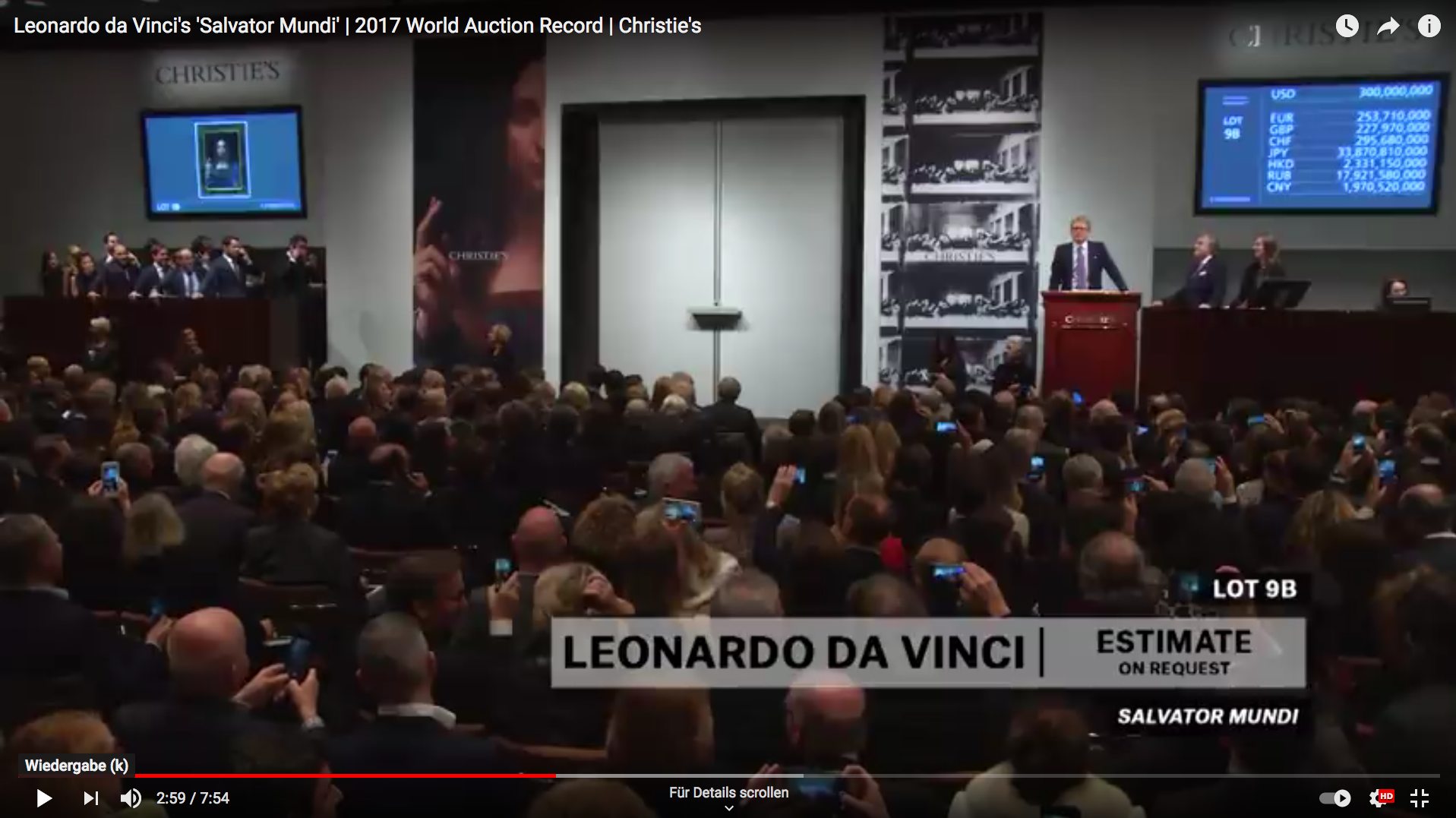
The 15 November 2017 inscribes into the chronicles of Santa Maria delle Grazie as well (pictures: youtube.com / Christie’s). Andy Warhol’s Sixty Last Suppers as well as the Salvator Mundi have their roots in the Milanese cloister. And there is something else: While the Salvator Mundi might mark the beginnings of serial production of paintings at the time of the Renaissance, Warhols work does practice and selfreferentially comment on serial production and on viral images (it had been a commission by an art dealer; see here). Does it also comment on the Salvator Mundi? How would Warhol have commented on the Salvator Mundi saga? Would he have created Sixty One Plus Salvator Mundi Versions? Perhaps he might have thought or said: why underestimating Leonardo? he did in fact invent the multiple. And perhaps Leonardo was even more furbo than anyone ever imagined – perhaps Leonardo did also invent and practice the selling of serial productions as (more or less unique) originals, each of every member of a series. Do we have a category for such objects, or do we still have to find one (even if just the Salvator Mundi version Cook might have been a gift and not a commercial product)?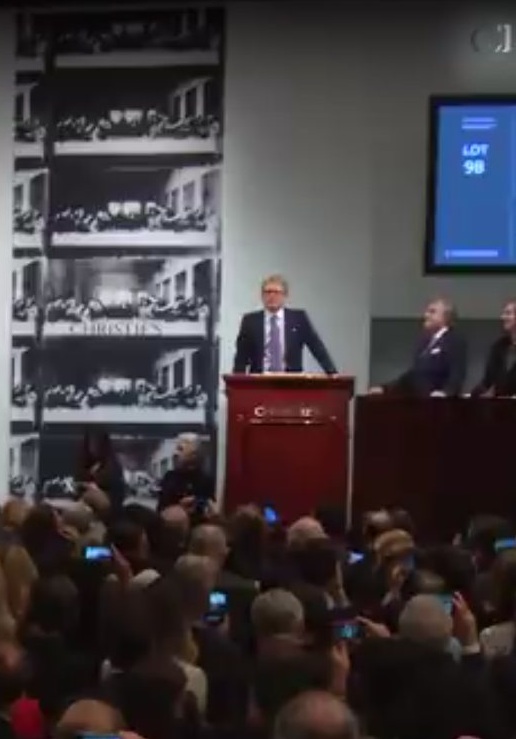
See also the episodes 1 to 11 of our New Salvator Mundi History:
Francis I and the Crown of Charlemagne
The Chronicles of Santa Maria delle Grazie
And:
MICROSTORY OF ART
ONLINE JOURNAL FOR ART, CONNOISSEURSHIP AND CULTURAL JOURNALISM
HOME
© DS